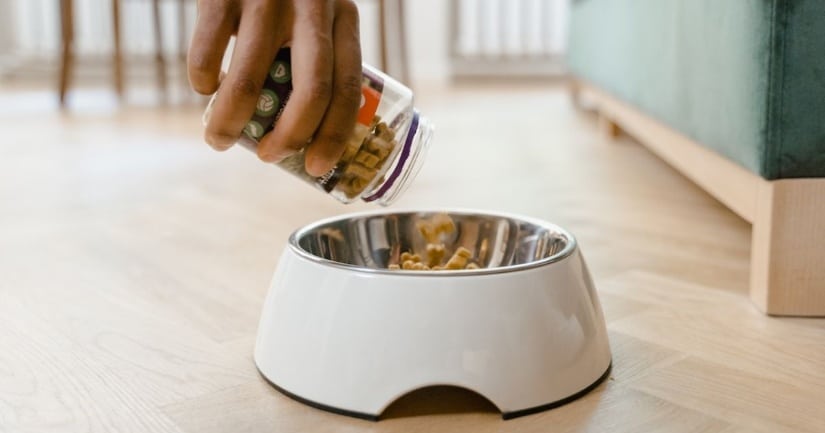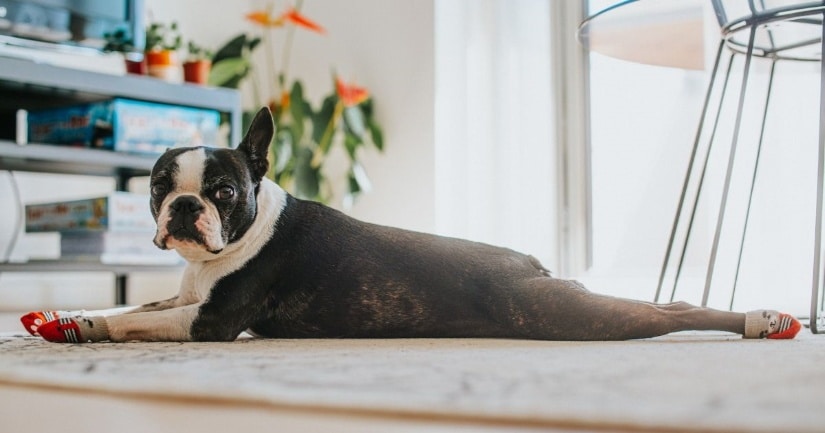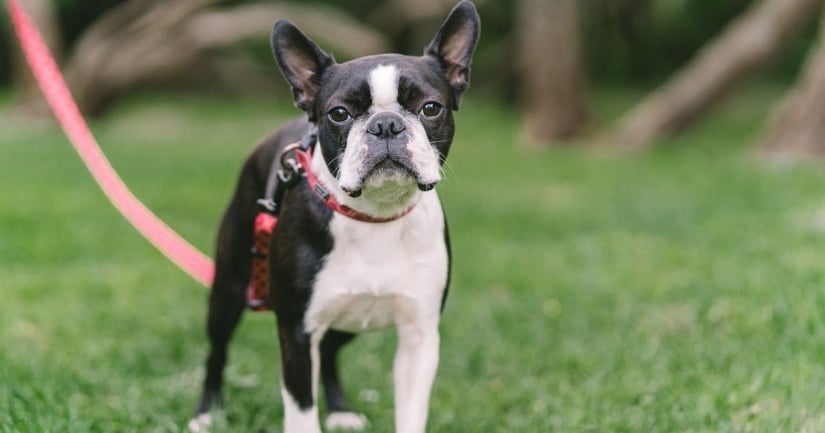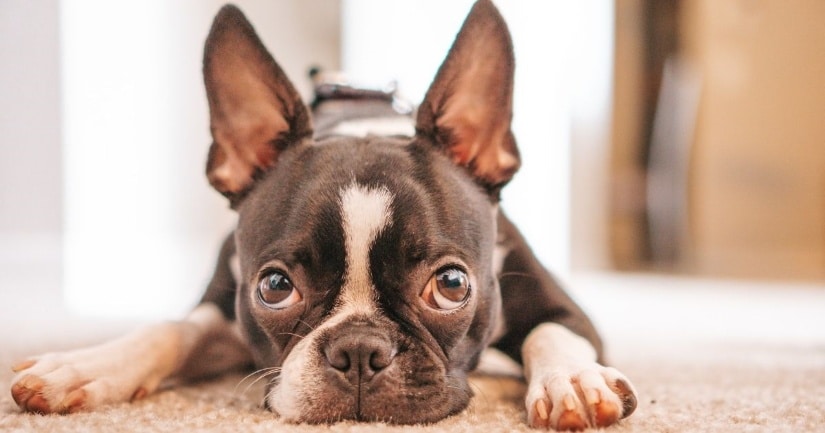Boston terriers are affectionate dogs that are willing to please and protect their owners, and learning how to care for a Boston terrier can help strengthen the bond between you and the dog. The following Boston terrier caring tips can help promote hygiene and prevent possible health risks.




Although Boston terriers have a life expectancy of around 11 to 13 years, this lifespan can be longer or shorter depending on how well you take care of the dog. Boston terriers are compact dogs that weigh less than 25 pounds.
Their small size makes them energetic and prone to obesity. Their short muzzles also make them prone to certain health issues, such as brachycephalic syndrome. Fortunately, the following tips can help you care for this terrier dog breed and improve its quality of life.
Give the Dog a Balanced Diet
A balanced diet should include high-protein content from eggs, fish, or lean-muscle, vitamins from fresh-cut vegetables such as kale and broccoli, and high levels of docosahexaenoic acid (DHA) and eicosapentaenoic acid (EPA) omega-3 fatty acids from krill oil.
The diet should also contain moderate animal fats such as sardines and salmon and minerals and water to keep the dog hydrated. Generally, you should avoid feeding your Boston grains and starchy foods such as potatoes.
Give the Dog the Right Amount of Food

Like other dog breeds, Boston terriers have strong appetites, and there are high chances of overfeeding and becoming obese if you leave them to free-feed. At the same time, the dog can become underweight and malnourished if you underfeed it.
Generally, you can feed your Boston around 1 to 2 cups of dog food per day. However, the best way to know whether you are giving the dog the right amount of food is by checking its weight. Boston terriers have three weight categories under 15 pounds, 15 to 20 pounds, and 20 to 25 pounds.
Consider giving the miniature versions smaller servings of around one cup and the versions that weigh around 25 pounds around two cups. You can increase the serving if the dog seems underweight depending on its weight category and reduce the portion if it seems overweight.
Feed the Dog at the Right Time

The strong appetites of Boston terriers make them anxious when their feeding time approaches, and they might become aggressive and stressed if you fail to feed them on time. You can prevent this stress by being consistent with the feeding time.
Feeding the dog at the same time every day also helps the stomach to adapt, over time helping to boost the dog’s digestive health. Generally, you should consider dividing the portion per day into meals, one in the morning and the other in the afternoon.
Although you can give the dog treats between the main meals, you should be mindful of the amount to avoid overfeeding the dog. For instance, if you give dog treats rich in calories during the mid-morning hours, consider reducing the evening portion.
Engage the Dog in Moderate Exercises
Like other dog breeds, Bostons require physical exercises for mental and physical stimulation. Usually, Bostons are energetic dogs and need about one hour of daily exercise to help them burn excess calories and keep them physically fit. This reduces the dog’s chances of developing destructive behaviors as it tries to use up the excess energy.
However, Boston terriers are brachycephalic dogs with short muzzles that make them prone to breathing problems. It’s therefore advisable to engage the dog in moderate exercises, such as walks, instead of exercises that might require bursts of energy, such as sprints and swimming.
Moderate exercise allows the dog to burn calories without significantly increasing its heartbeat and breathing rate. Since Boston terriers are curious, you can vary the route, terrain, and distances to prevent boredom and keep the dog interested and motivated.
Take the Dog for Regular Medical Checkups
Generally, taking your dog to a vet for medical checkups helps the vet diagnose any underlying health issue earlier, increasing the chances of successful treatments. Even if your dog might look healthy, Boston terriers are prone to the following health conditions, and a vet can help diagnose them.
- Glaucoma: Boston terriers have big eyes compared to their sizes. This increases the chances of obstruction of the drainage system of the eyeball, causing pressure that causes nerve damage. A vet can prescribe medications that can help lower this pressure
- Ear infections: The large, bat-like ears of the Bostons make them prone to allergies that cause ear infections. A vet can help check for infections and treat the condition early enough
- Skin allergies: The wrinkled skin of a Boston can harbor mold, pollen, dust, and allergens, increasing the chances of skin allergies. The dog might start scratching, licking, or even biting itself. A vet can help you determine the root cause of the problem
- Patellar luxation: Patellar luxation is a condition where the kneecap slips out of its groove, causing pain that might make the dog limp. A vet can help detect the problem early enough and advise you on the best measures to take, such as engaging the dog in a weight-loss plan
Ensure the Environment Is Safe for the Dog
Although Bostons are considered intelligent dogs, they are not as intelligent as humans and might not know what is hazardous to them. One of the ways to take care of your dog is to ensure the environment poses no risk to the dog.
For instance, Boston terriers are territorial and protective of their families. They are also curious and love to explore around. As a result, there are chances of the dog straying away or even picking fights with other dogs or pets from the neighborhood.
You can minimize these risks by ensuring the dog stays on a leash outdoors, or the compound is well-fenced. Keeping in mind that the dog is also prone to patellar luxation conditions, you can ensure the dog is safe by ensuring it’s not walking on steep stairs, climbing and jumping off from heights, or walking on slippery floors.
Keep the Dog’s Designated Place Clean and Comfortable
Like humans, dogs also need a place to sleep and rest. Keeping in mind that Boston terriers generally sleep for around 12 to 14 hours per day, and senior dogs might even sleep for longer, it means the dog spends much of its life sleeping.
Since Boston terriers are prone to breathing problems, dust and dog hair can increase the risks. The following tips can help keep your dog’s designated place clean and hygienic to prevent allergens.
- Get your Boston terrier a bed that is designed to reduce bad smells. Usually, a good bed should be mold-resistant and flea-resistant, features a hypoallergenic memory foam and the liners are waterproof, removable, and machine-washable.
- Wash your Boston paws to remove germs and dirt before getting to bed. This helps to reduce the buildup of bacteria
- Consider vacuuming the bed in between washes to remove dust and dander that might cause skin allergies and breathing issues
- Put the bed in sunlight around once per week to help remove odors and kill bacteria that might be building up
- Depending on the level of dirt buildup, consider wiping the bed with a mixture of white vinegar and a small amount of water once per week
- If the other rooms have things that are hazardous to the dog, such as cosmetics or sharp objects, consider getting a dog gate to help limit the dog’s access to other rooms
- The Boston terriers’ short snouts make them intolerant to heat, and they require plenty of water to keep them hydrated. Place a bowl of clean drinking water that the dog can access at all times
Spend Time With the Dog

Generally, Boston terriers are affectionate dogs and love spending time with their owners. If you fail to give your dog enough attention or leave it alone for an extended time, it might develop separation anxiety. Some signs that your dog is stressed might include chewing objects such as electronics or furniture.
Over time, the bond between you and the dog might break, and it might lose interest in you. Usually, this makes it challenging to control the dog even when going for exercises. The best way to strengthen the bond is to spend time with the day.
You can also give the dog treats after leaving it alone. This makes the dog dependent on you, which makes it more obedient and willing to please you. However, avoid giving treats every time you return home, as this can become a bad habit.
Groom the Dog Regularly
Boston terriers have short, smooth, and fine-textured coats that might not need to be trimmed or shaved. However, the dog is a moderate shedder with the following grooming requirements.
- Brushing: The best way to reduce shedding and maintain the good look of the coat is to brush it around once per week using a soft-bristled brush. You can also use a hound glove to brush the dog’s hair in the direction of its growth to remove the dead undercoat and brush off dry mud and dirt before bathing
- Bathing: Consider bathing the dog around once per four to six weeks unless it gets excessively muddied or dirty during exercises. Bath the dog using shampoos formulated for smooth-coated dog breeds, then rinse with clean water. Avoid over-bathing the dog so you don’t end up stripping the natural oils
- Dental care: Regularly check the dog’s teeth for tartar buildup on the teeth’s surface. Brush the dog’s teeth around two times a week using the dog’s toothpaste and toothbrush. However, if you are giving the dog sugary treats, consider brushing its teeth daily
- Eye care: The big eyes of the Boston terriers make them prone to dirt and debris, which usually results in discharge that discolors the fur under the eyes. Use a warm, damp cloth to wipe the area around the eyes. Wipe the eyes from the eyelid downward towards the cheek, taking care not to injure the eye or introduce debris
- Nail trimming: Usually, the dog’s nails can grow long, and the dog might injure itself when scratching itself or even scratch and damage things in the house. You can trim the nails when they are soft after bathing. However, nail trimming is sensitive, and it’s advisable to get the help of a professional groomer if you are a beginner
- Ear care: The bat-like ears tend to collect dirt over time. Even if you try to prevent water from getting into the ears when bathing the dog, there are still chances of moisture reaching the ears. Usually, this results in mud-like dirt that can be a harboring ground for bacteria. Consider wiping the dog’s ear flaps and the upper part of the ear canal using a moist cloth after bathing the dog
Frequently Asked Questions

How Can I Know My Boston Terrier Is Sick?
You can know your Boston terrier is sick through physical signs such as diarrhea, vomiting, and hair loss. Usually, this indicates stomach complications or skin allergies. On the other hand, the dog might cough, wheeze or show trouble breathing if it’s suffering from breathing conditions.
However, even if the dog doesn’t show these physical signs, some behavioral changes indicate an underlying health condition, such as unwillingness to play, unexplained loss of appetite, and weight loss.
Can I Hire a Pet Sitter to Take Care of My Boston Terrier?
Yes, you can hire a pet sitter to take care of your Boston terrier. Usually, pet sitters are professionals familiar with Boston terriers’ temperament, nutrition, and exercise requirements. It’s advisable to hire a pet sitter with some veterinary background as they can help detect underlying health conditions early enough.
Final Thoughts
Knowing how to care for a Boston terrier can help bond with the dog and prevent life-threatening health conditions such as breathing problems. Ensure you are feeding your dog the right amount of nutritious foods at the right time and providing a safe and clean environment.
